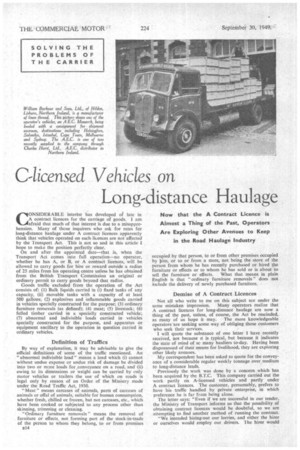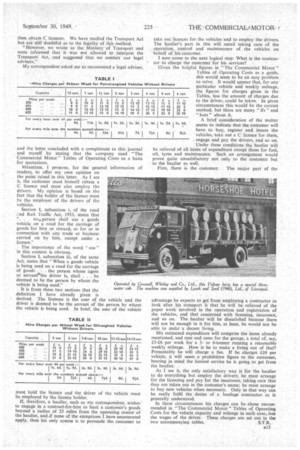Glicensed Vehicles on Long-distance Haulage
Page 48

Page 49

If you've noticed an error in this article please click here to report it so we can fix it.
Now that the A Contract Licence is Almost a Thing of the Past, Operators Are Exploring Other Avenues to Keep in the Road Haulage Industry CONS1DERABLE interest has developed of late in A contract licences for the carriage of goods. 1 am afraid that much of that interest is due to a misapprehension. Many of those inquirers who ask for rates for Tong-distance haulage under A contract licences apparently think that vehicles operated on suchlicences are not affected by the Transport Act. This is not so and in this article I hope to make the position perfectly clear.
On and after the appointed date—that is, when the Transport Act comes into full operation—no operator, whether he has A, or B, or A contract licences, will be allowed to carry goods for hire or reward outside a radius of 25 miles from his operating centre unless he has obtained from the British Transport Commission an original or ordinary permit to carry goods beyond that radius.
Goods traffic excluded from the operation of the Act consists of: (1) Bulk liquids carried in (i) fixed tanks of any capacity, (ii) movable tanks with a capacity of at least 500 gallons; (2) explosives and inflammable goods carried in vehicles specially constructed for the purpose; (3) ordinary furniture removals (as defined); (4) meat; (5) livestock; (6) felled timber carried in a specially constructed vehicle; (7) abnormal and indivisible toads carried in vehicles specially constructed for the purpose, and apparatus or equipment ancillary to the operation in question carried in ordinary vehicles.
Definition of Traffics
By way of explanation, it may be advisable to give the official definitions of some of the traffic mentioned. An "abnormal indivisible load" means a load which (i) cannot without undue expense or undue risk of damage be divided into two or more loads for ,conveyance on a road, and (ii). owing to its dimensions or weight can be carried by only motor vehicles or trailers the use of which on roads is legal only by reason of an Order of the Ministry made under the Road Traffic Act, 1930.
"Meat" means carcases of animals, parts of carcases of animals or offal of animals, suitable for human consumption, whether fresh, chilled or frozen, but not carcases, etc., which have been cooked or subjected to any process other than skinning, trimming or cleaning.
"Ordinary furniture removals" means the removal of furniture or effects, not forming part of the stock-in-trade of the person to whom they belong, to or from premises B14
occupied by that person, to or from other premises occupied by him, or to or from a store, not being the store of the person from whom he has recently purchased or hired the furniture or effects or to whom he has sold or is about to sell the furniture or effects. What that means in plain English is that "ordinary furniture removals" does not kid tide the delivery of newly purchased furniture.
Demise of A Contract Licences
Not all who write to me on this subject are under the
same mistaken impression. Many operators realize that A contract licences for long-distance haulage are now a thing of the past, unless, of course, the Act be rescinded, as many of us hope it may. The more knowledgeable operators -are seeking some way of obliging those customers who seek their services.
I will quote the substance of one letter I have recently received, not because it is typical, but because it indicates the state of mind of sc many hauliers to-day. Having been dispossessed of their means for livelihood, they are exploring other likely avenues. My correspondent has been asked to quote for the conveyance of a considerable regular weekly tonnage over medium to long-distance leads.
Previously the work was done by a concern which has been acquired by the B.T.C. This company carried OW the work partly on A-licensed vehicles and partly under A contract licences. The customer, presumably, prefers to have his traffic handled by private enterprise, in which preference he is far from being alone. The letter says: "Even if we are successful in our tender, the Ministry of Transport informs us that the possibility of obtaining contract licences would be doubtful, so we are attempting to find another method of running the contract. We intended hiring-out our lorries, and either the hirer or ourselves would employ our drivers. The hirer would
then obtain C licences. We have studied the Transport Act but are still doubtful as to the legality of this method.
"However, we wrote to the Ministry of Transport and were informed that it was not allowed to interpret the Transport Act, and suggested that we contact our legal advisers."
My correspondent asked me to recommend a legal adviser, and the letter concluded with a compliment to this journal and myself by stating that the company used "The Commercial Motor" Tables of Operating Costs as a basis for quotations.
Meantime, I propose, for the general information of readers, to offer my own opinion on
the point raised in this letter. As I see it, the customer must himself obtain a C licence and must also employ the drivers. My opinion is based on the fact that the holder of the licence must 1-e the employer of the drivers of the vehicles.
Section 1, subsection i, of the road ;-.nd Rail Traffic Act, 1933, states that
". . no. person shall use a goods vehicle on a road for the carriage of goods for hire or reward, or for or in connection with any trade or business carried on by him, except under a licence."
The importance of the word "use" in this context is obvious.
Section 1, subsection iii, of the same Act, states that "When a goods vehicle is being used on a road for the carriage
of goods . the person whose agent or servantwthe driver is, shall . . . be deemed to be the person by whom the vehicle is being used."
It is from these two sections that the definition I have already given is derived. The licensee is the user of the vehicle and the driver is deemed to be the servant of the person by whom the vehicle is being used. In brief, the user of the vehicle must hold the licence and the driver of the vehicle must be employed by the licence holder.
If, therefore, a haulier, such as my correspondent, wishes' to engage in a contract-for-hire to haul a customer's goods beyond a radius of 25 miles from the operating centreof the haulier, andif none of the exceptions I have enumerated apply, then his only course is to persuade the customer to take out licences for the vehicles and to employ the drivers. The haulier's part in this will entail taking care of the operation, control and maintenance of the vehicles on behalf of his,customer.
I now come to the next logical step: What is the contractor to charge the customer for his services?
Given the helpful figures in "The Commercial Motor" Tables of Operating Costs as a guide, this would seem to be an easy problem to solve. It would appear that, for any particular vehicle and weekly mileage, the figures for charges given in the Tables, less the amount of charges due to the driver, could be taken. In given circumstances this would be the correct method, but there are many " ifs " and " buts " about it.
A brief consideration of the matter seems to indicate that the customer will have to buy, register and insure the vehicles, take out a C licence for them, , engage and pay the drivers, and so on. Under these conditions the haulier will be relieved of all items of expenditure except those for fuel, oil, tyres and maintenance. Such an arrangement would prove quite unsatisfactory not only to the customer but to the haulier as well.
First, there is the customer. The major part of the
4 ton 5 ton 6 tan s. £ s. 4 s.
15 5 17 10 17 10 20 5 19 10 23 0 0 22 0 25 10
advantage he expects to get" from employing a contractor to look after his transport is that he will be. relieved of the paper work involved in the operation and registration of the vehicles, and that concerned with licensing, insurance, and so on. The haulier will be dissatisfied because there will not be enough in it for him, at least, he would not be able to make a decent living.
His estimated expenditure will comprise the items already mentioned, and rent and rates for the garage, a total of, say, 1546 per week for a 5or 6-tonner running a reasonable weekly mileage. How is he to make a living out of that? Presumably he will charge a fee. If he charges £10 per vehicle, it will seem a: prohibitive figure to the customer, bearing in mind the limited service he is going to get from the haulier.
As I see it, the only satisfactory way is for the haulier to do everything but employ the drivers; he must arrange for the licensing and pay for the insurance, taking care that they are taken out in the customer's name; he must arrange to buy new vehicles when necessary. Only in that way can he really fulfil the duties of a haulage contractor as is generally understood.
In these circumstances his charges can be Those recommended in "The Commercial Motor" Tables of Operating Costs for the vehicle capacity and mileage in each case,., less the wages of the driver. These charges are set out in the
two accompanying tables. S.T.R.




















































































